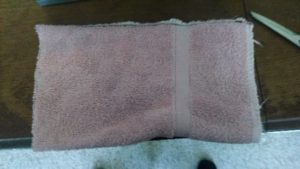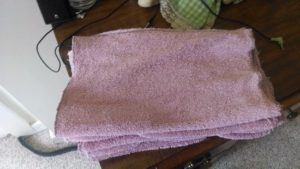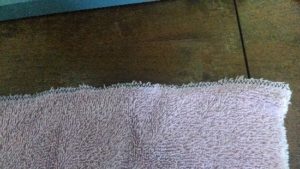I don’t use paper towels to clean up anything but mess from a pet. While yes, you could call it an environmental thing, I use cloth for cleaning the same as I use cloth napkins for everyday.
I find buying stuff specifically to throw away a waste of money. If you can safely wash it and reuse it for cleaning purposes, it’s cheaper to do so. You can find all kinds of cleaning cloths out there that’ll last years.
I don’t find most commercial cleaning cloths sturdy enough for my liking, so I make my own out of worn-out towels. I have a couple of sets that have been getting frayed around the edges and have ample newer ones, so it’s time to make a cleaning cloth.
I got the idea from Is There Life After Housework? by Don Aslett. You take a rectangular piece of cloth – preferably something strong and absorbent. Old cotton towels are great for this, and so are old diapers.
The cool part is that instead of rags, you make a tube out of the cloth. By folding, you get a pretty sturdy cleaning surface, and when it gets a bit dirty, you can refold and turn it inside out for fresher cleaning surfaces. When you’re done, toss in the wash, no biggie.
Since I use towels for this, I’ll show you how I do it.

So by folding a towel in half widthwise, cutting then doing the same again to the two halves you’ve generated, then cutting those four pieces in half again, you can get eight pieces of cloth out of your old towel.
And there’s no reason in the world not to go ahea d and use them as cleanin
d and use them as cleanin g rags right then, of course. If that’s your thing, go for it.
g rags right then, of course. If that’s your thing, go for it.
I like the tubes, so I go a little further and sew up these babies.
I do use a zig-zag stitch along the long edge, or use a serger to finish what will be the open edges of the tubes. It makes them last longer instead of falling apart from fraying and leaving fluff everywhere. Notice I used black thread on the old pink towels I used. I confess this was not done for contrast and an example, but out of sheer laziness because I didn’t feel like bothering to match the thread for cleaning supplies. You want yours to look pretty, go ahead and show me up. J
 After I’ve finished the long edges, I go ahead and sew them into tubes using a zig-zag stitch. I do this for strong seam with a bit of self-finishing on one go. They’re meant or cleaning, so I don’t feel like it’s necessary to spend an extraordinary amount of time on them. Eight in a half hour is plenty enough time to spend.
After I’ve finished the long edges, I go ahead and sew them into tubes using a zig-zag stitch. I do this for strong seam with a bit of self-finishing on one go. They’re meant or cleaning, so I don’t feel like it’s necessary to spend an extraordinary amount of time on them. Eight in a half hour is plenty enough time to spend.
These cloths also make great potholders. The double layer of thick cotton cloth is pretty good at protecting from heat.
As long as it’s not damp.
Here’s the set I made today. Did it because most of the old ones I made ten years ago have frayed apart from heavy use and I’m on a spring cleaning spree.







 After I’ve finished the long edges, I go ahead and sew them into tubes using a zig-zag stitch. I do this for strong seam with a bit of self-finishing on one go. They’re meant or cleaning, so I don’t feel like it’s necessary to spend an extraordinary amount of time on them. Eight in a half hour is plenty enough time to spend.
After I’ve finished the long edges, I go ahead and sew them into tubes using a zig-zag stitch. I do this for strong seam with a bit of self-finishing on one go. They’re meant or cleaning, so I don’t feel like it’s necessary to spend an extraordinary amount of time on them. Eight in a half hour is plenty enough time to spend.
 I’ve got a sock and a sweater on the needles at the moment. Why? Well, socks are a portable project. They’re easy to toss in a purse and perfect to keep one distracted in waiting rooms, on buses and to relax on a lunch break. The sweater I am working on is in the bulky stage. I usually knit in the round, so sweater sleeves might be delightfully portable, but when you attach them to the body, any sweater for an adult becomes really bulky. That’s my writin’ chair project.
I’ve got a sock and a sweater on the needles at the moment. Why? Well, socks are a portable project. They’re easy to toss in a purse and perfect to keep one distracted in waiting rooms, on buses and to relax on a lunch break. The sweater I am working on is in the bulky stage. I usually knit in the round, so sweater sleeves might be delightfully portable, but when you attach them to the body, any sweater for an adult becomes really bulky. That’s my writin’ chair project.